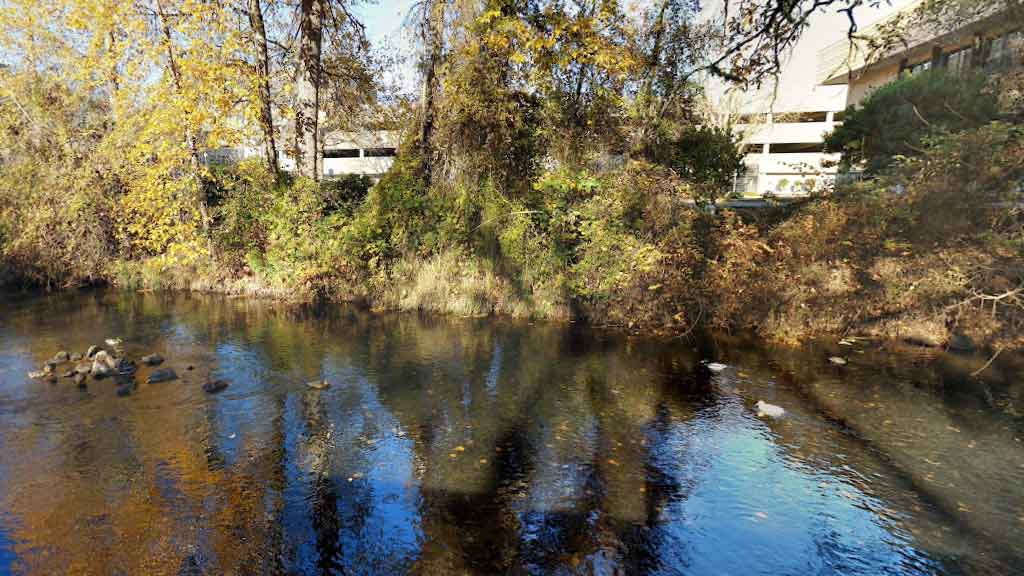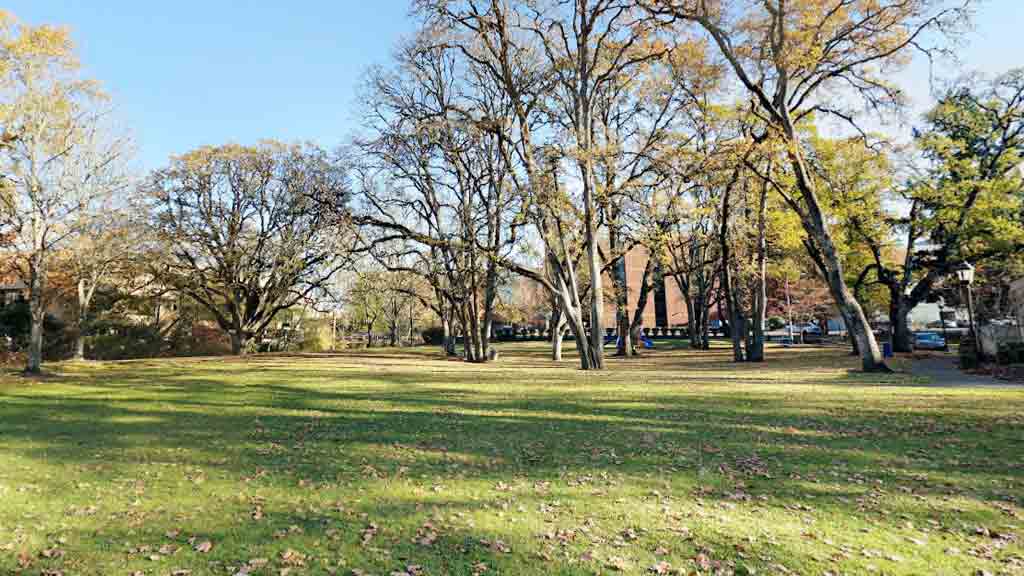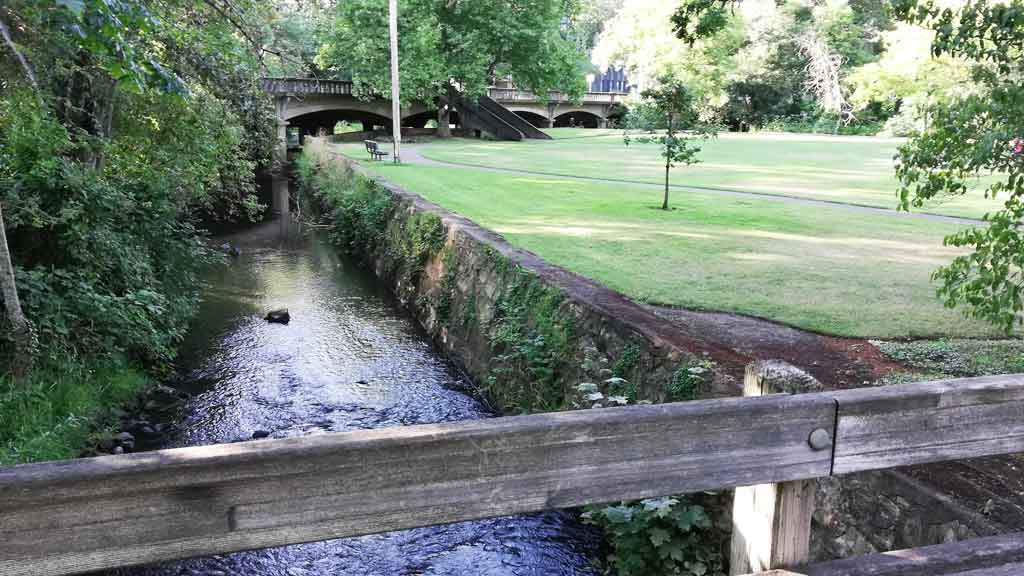Did you know Pringle Park in Salem, Oregon, holds a chilling piece of history? Located just southeast of the downtown core along the south bank of Pringle Creek, this serene park was once the site of Salem’s designated hanging grounds.
The ominous trees that still stand today whisper tales of judicial punishments from a bygone era.
Unlike its infamous Massachusetts namesake, Salem, Oregon, doesn’t have centuries of history or witch trials. However, Pringle Park’s past offers a unique glimpse into the darker side of the city’s history.
As you stroll through the park, you can’t help but wonder about the events that transpired beneath those ancient branches.
Today, Pringle Park is a peaceful retreat for locals and visitors alike. It features walking trails, picnic areas, and lush green spaces that provide a stark contrast to its haunting past.
Historical Context of Pringle Park
Pringle Park, located in Salem, Oregon, carries significant historical and cultural value, tracing back to the city’s early development.
The park’s history intertwines with the broader narrative of Salem’s growth and the establishment of its public spaces.
Early Settlements and Development

Pringle Park in Salem, Oregon, holds a significant place in the city’s early development. It sits at the heart of where numerous settlers first established their homes in the mid-1800s.
These settlers, attracted by the region’s fertile land and access to Mill Creek, set in motion the area’s transformation.
Mill Creek played a crucial role in the growth of Salem. It not only provided essential water resources for agriculture but also powered various mills, including the Thomas Kay Woolen Mill.
The proximity of Pringle Park to these operational hubs made it a central landmark within the community as Salem expanded.
Historic Events and Changes
The historical landscape of Pringle Park is marked by several significant events. One notable feature is its previous role as the city’s designated hanging grounds, contributing to its somber past. The park was a site where public punishments were carried out, reflecting the judiciary practices of that era.
Another pivotal change in Pringle Park’s history occurred when the construction of key infrastructures reshaped the area.
The development of Waller Dam in 1864, which was reconstructed in 1915, altered the course of Mill Creek, impacting the park’s surroundings.
Mill Creek’s division into the millrace and North Mill Creek further influenced the park’s geographical and functional dynamics. Over time the park evolved, moving away from its dark history to become a place of tranquility and leisure.
While modern visitors may enjoy its serene environment, the historical shifts and events that transpired here provide a profound narrative, underscoring the park’s transformation through Salem’s history.
Pringle Park Today

Pringle Park, located in the heart of Salem, Oregon, serves as a vital green space for the community, combining recreational amenities with natural beauty.
The park’s design and facilities reflect the city’s commitment to providing a welcoming environment for all its residents and visitors.
Geographic and Cultural Significance
Pringle Park, located southeast of Salem’s downtown core, sits along the south bank of Pringle Creek. The park, a former judicial punishment site, offers a glimpse into Salem’s darker history.
Today, it serves as a key cultural landmark, retaining its historical significance while integrating into modern Salem’s urban landscape.
The park features informative plaques, walking trails, and community spaces, making it a popular spot for both locals and visitors.
It stands as a testament to Salem’s ability to preserve its history while promoting recreational and educational activities.
Recreational Activities and Community Engagement
Pringle Park offers a variety of recreational activities. Visitors enjoy walking trails, picnic areas, and scenic views of Pringle Creek. Each spring, blooming camas blossoms attract nature enthusiasts, showcasing the park’s natural beauty.
Community events, held throughout the year, foster engagement among Salem’s residents, transforming Pringle Park into a vivid community hub.
Established in the early 20th century, Pringle Park has a rich history that reflects Salem’s growth and development.
The park’s carefully preserved natural landscapes and historical landmarks provide visitors with a glimpse into the city’s past, making it a cherished local treasure.
Key Figures in Pringle Park History
The history of Pringle Park in Salem, Oregon, is shaped by several key figures whose contributions have been instrumental in its development and preservation.
Here are some notable individuals who played significant roles in the history of Pringle Park:
Influential Personalities and Families

Several influential personalities and families have deeply impacted Pringle Park’s development and history. Reverend A.L. Waller, a key figure, donated the land that eventually became known as Waller Dam.
This contribution significantly influenced the area’s water management and industrial activities. The millrace constructed near Pringle Park in 1864, powered by Mill Creek, highlights his visionary contributions.
The Thomas Kay family, associated with the Thomas Kay Woolen Mill, played a crucial role in shaping the park’s industrial landscape.
Their mill, which utilized the millrace, was pivotal in bolstering Salem’s economy during the late 19th century. The family’s entrepreneurial spirit transformed the park area into a thriving industrial hub.
Notable Public Figures
Several notable public figures have left their mark on Pringle Park’s history. William Willson, who platted Salem in 1850, influenced the park’s early layout and positioning.
His work in establishing the town’s structure set the stage for Pringle Park’s integration into Salem’s urban fabric.
Additionally, the park’s historical ties to local governance are evident through its proximity to the locations of Salem’s three Capitol buildings, which have all succumbed to fire over the years.
The loss of lives and records in these fires added to the area’s rich and somber history. The reconstructed Capitol building, completed in 1938 and oriented differently from its predecessors, stands as a testament to the resilience and evolving governance of the city.
These figures and their contributions illustrate the dynamic interplay between industrial advancements, civic planning, and community development, shaping Pringle Park into the cultural and historical landmark it is today.
Architectural and Natural Highlights
Pringle Park in Salem, Oregon, is a blend of thoughtful architecture and natural beauty, creating a harmonious environment that appeals to a wide range of visitors.
Here are some of the park’s most notable architectural and natural highlights:
Gaiety Hill Historic District
Gaiety Hill Historic District offers a glimpse into Salem’s architectural past. This area, located south of downtown, features well-preserved residences from the late 19th and early 20th centuries.
Many houses in the district showcase architectural styles such as Colonial Revival and Craftsman. You can find the elegant Bush House Museum here, an excellent example of Victorian architecture.
Adjacent to the Gaiety Hill area is Pringle Park, which played a significant role in the community’s development. Established in the early 1900s, the park has served both as a recreational space and a historical landmark.
Visitors to Pringle Park can enjoy its serene atmosphere while exploring its rich history, making it a perfect complement to the architectural treasures found in the Gaiety Hill Historic District.
Unique Features of Pringle Park
Pringle Park’s unique features make it a standout destination for visitors. The park contains many large, ancient trees, some of which served as hanging grounds in the past.
Waller Dam, constructed around 1864 and rebuilt in 1915, causes Mill Creek to split into its millrace and North Mill Creek. The millrace, a manmade channel, winds through the park, providing scenic views and blending history with nature.
In recent years, the Pringle Square Apartments project has enhanced the park’s appeal. This mixed-use development repurposes an old mill, incorporating 107 residential units and 20,000 square feet of commercial space.
A creekside esplanade ties the area together, connecting Pringle Park to Riverfront Park and downtown trails. Plans for a pedestrian bridge to Minto-Brown Island Park aim to further integrate the park with surrounding recreational spaces.
Frequently Asked Questions
What is the historical significance of Pringle Park in Salem, Oregon?
Pringle Park was originally the hanging grounds of Salem in the mid-1800s. Over time, it transformed into a vital recreational space, thanks in part to the construction of the Waller Dam and the efforts of influential figures like Reverend A.L. Waller and William Willson.
What role did Waller Dam play in the development of Pringle Park?
Built in 1864 and reconstructed in 1915, Waller Dam was pivotal in creating the millrace that powered various industries. This development helped shape Pringle Park into an essential part of Salem’s industrial and recreational landscape.
Who were some key figures in the development of Pringle Park?
Reverend A.L. Waller and William Willson played significant roles in shaping the park’s layout and orientation, contributing to its historical and cultural heritage.
What architectural features can be found in the Gaiety Hill Historic District?
The Gaiety Hill Historic District showcases Victorian architecture, adding to the historical and visual appeal of the area surrounding Pringle Park.
What recent enhancements have been made to Pringle Park?
Recent enhancements include the Pringle Square Apartments project and planned construction of a pedestrian bridge to Minto-Brown Island Park. These efforts aim to integrate the park with surrounding recreational spaces and promote environmentally-friendly practices.
How does Pringle Park support local wildlife and Salem’s urban canopy?
Pringle Park follows environmentally-friendly practices to support local wildlife and maintain Salem’s urban canopy, highlighting the community’s commitment to preserving natural habitats within the city.
Conclusion
Pringle Park’s history ties deeply into Salem’s evolution. Initially used as the city’s hanging grounds in the mid-1800s, the park has transformed significantly.
Waller Dam, built around 1864 and reconstructed in 1915, contributed to the development of the area.
The dam’s construction led to the creation of the millrace, a manmade channel along Ferry Street that powered industries like the Thomas Kay Woolen Mill and later supported Boise Cascade and an oil company.
Key figures such as Reverend A.L. Waller and William Willson influenced the development of this area. Reverend Waller, for whom the dam is named, donated land that became pivotal in shaping the park’s layout.
William Willson, who platted the original city layout, left a lasting impact on the park’s orientation and development.
Jaclyn Lowe